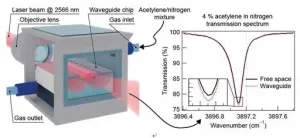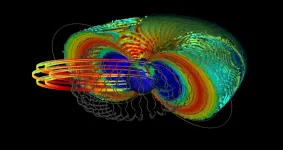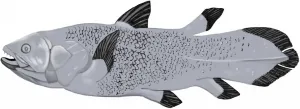(Press-News.org) The Bronze Age (2200 to 800 BC) marked a decisive step in the technological and economic development of ancient societies. People living at the time faced a series of challenges: changes in the climate, the opening up of trade and a degree of population growth. How did they respond to changes in their diet, especially in Western Switzerland? A team from the University of Geneva (UNIGE), Switzerland, and Pompeu Fabra University (UPF) in Spain has for the first time carried out isotopic analyses on human and animal skeletons together with plant remains. The scientists discovered that manure use had become widespread over time to improve crop harvests in response to demographic growth. The researchers also found that there had been a radical change in dietary habits following the introduction of new cereals, such as millet. In fact, the spread of millet reflected the need to embrace new crops following the drought that ravaged Europe during this period. Finally, the team showed that the resources consumed were mainly terrestrial. The research results are published in the journal PLOS ONE.
Today, archaeological resources for studying the Bronze Age are limited. "This is partly down to changes in funeral rituals," begins Mireille David-Elbiali, an archaeologist in the Laboratory of Prehistoric Archaeology and Anthropology in the F.-A. Forel Department in UNIGE's Faculty of Sciences. "People gradually abandoned the inhumation practice in favour of cremation, thereby drastically reducing the bone material needed for research. And yet the Bronze Age signals the beginning of today's societies with the emergence of metallurgy." As the name suggests, societies began working with bronze, an alloy consisting of copper and tin. "And this development in metallurgy called for more intensive trade so they could obtain the essential raw materials. This increased the circulation of traditional crafts, prestigious goods, religious concepts and, of course, people between Europe and China," continues the archaeologist.
Diet imprinted in bones
The Neolithic Age marked the inception of animal husbandry and the cultivation of wheat and barley. But what about the diet in the next Bronze Age? Archaeobotany and archaeozoology have been routinely used to reconstruct the diet, environment, agricultural practices and animal husbandry in the Bronze Age, but these methods only provide general information. "For the first time, we decided to answer this question precisely by analysing human and animal skeletons directly. This meant we could study the stable isotopes from the collagen of the bones and teeth that constitute them and define their living conditions," continues Alessandra Varalli, a researcher in UPF's Department of Human Sciences and the study's first author. "In fact, we are what we eat," points out Marie Besse, a professor in the Laboratory of Prehistoric Archaeology and Anthropology in the F.-A. Forel Department at UNIGE. Biochemical analyses of bones and teeth will tell us what types of resources have been consumed." Forty-one human skeletons, 22 animal skeletons and 30 plant samples from sites in Western Switzerland and Haute-Savoie (France) were studied, ranging from the beginning to the end of the Bronze Age.
No differences between men, women and children
The study's first outcome showed that there was no difference between the diets of men and women, and that there were no drastic changes in diet between childhood and the adult phase of these individuals. "So, there was no specific strategy for feeding children, just as men didn't eat more meat or dairy product than women. What's more, when it comes to the origin of the proteins consumed, it was found that although Western Switzerland is home to a lake and rivers, the diet was mainly based on terrestrial animals and plants to the exclusion of fish or other freshwater resources," adds Dr Varalli. But the main interest of the study lies in plants, which reveal societal upheavals.
Agriculture adapted to climate change
"During the early Bronze Age (2200 to 1500 BC), agriculture was mainly based on barley and wheat, two cereals of Near Eastern origin that were grown from the Neolithic Age in Europe», explains Dr Varalli. "But from the late Late Bronze Age (1300 to 800 BC), we note that millet was introduced, a plant from Asia that grows in a more arid environmen." In addition, nitrogen isotopes revealed that manuring was used more intensively. "The analysis of several plant species from different phases of the Bronze Age suggests that there was an increase in soil fertilisation over time. This was most likely to boost the production of agricultural crops."
These two discoveries combined seem to confirm the general aridity that prevailed in Europe during this period, which meant agriculture had to be adapted; and that there was heightened trade between different cultures, such as Northern Italy or the Danube region, leading to the introduction of millet into Western Switzerland. These new cereals might have played an important role in the security of supply, and perhaps contributed to the population increase observed in the Late Bronze Age. In fact, these cereals grow more quickly and are more resistant to drought, at a time when the climate was relatively warm and dry. Finally, the use of fertiliser went hand-in-hand with a general improvement in techniques, both agricultural and artisanal. "This first study on changes in diet in Western Switzerland during the Bronze Age corroborates what we know about the period. But it also demonstrates the richness of the widespread intercultural exchanges," states Professor Besse with enthusiasm. We still have much to learn about this millennium, in spite of the scientific problems related to the paucity of available material. "This is one of the reasons that led me to excavate the Eremita cave with UNIGE students. Located in the Piedmont region of Italy, it is dated to the Middle Bronze Age around 1600 BC," concludes Professor Besse.
INFORMATION:
This study by UNIGE and UPF was carried out in collaboration with the University of Neuchâtel (UNINE) and Aix-Marseille (Lampea, France).
Optical waveguides suspended in air are capable to beat free-space laser beams in light-analyte interaction even without complex dispersion engineering. This phenomenon has been predicted more than 20 years ago, yet never observed in experiment.
In a new paper published in Light Science & Application, a team of scientists, led by Professor Jana Jágerská from Department of Science and Technology, UiT The Arctic University of Norway, and co-workers have devised a mid-infrared free standing solid core optical waveguide which pushes the light interaction with the surrounding air beyond what has been reported up until now: 107 % interaction strength compared to that of a free-space beam has been demonstrated.
"The guided mode of our thin waveguide ...
New study found that electrons can reach ultra-relativistic energies for very special conditions in the magnetosphere when space is devoid of plasma.
Recent measurements from NASA's Van Allen Probes spacecraft showed that electrons can reach ultra-relativistic energies flying at almost the speed of light. Hayley Allison, Yuri Shprits and collaborators from the German Research Centre for Geosciences have revealed under which conditions such strong accelerations occur. They had already demonstrated in 2020 that during solar storm plasma waves play a crucial role for that. However, it was previously unclear why such high electron energies are not achieved ...
The COVID-19 pandemic has upended many parts of daily life, one of them being our work life. Research carried out by the Universitat Oberta de Catalunya (UOC) has studied the factors that help make efficient work teams. The explanation is multidimensional and multilevel.
"Inspiring leadership builds employees' resilience and willingness to undertake new challenges," said Pilar Ficapal Cusi, professor at the UOC's Faculty of Economics and Business and one of the authors of the study, which was published in the Journal of Cleaner Production.
Viewed from the group and organizational perspective, "the shared vision, the team's belief in its own creative effectiveness, the ability to reflect openly about how their members connect to adapt ...
Researchers at Lund University in Sweden have discovered the individual traits of fungi, and how their hyphae - that is, the fungal threads that grow in soil - behave very differently as they navigate through the earth's microscopic labyrinths.
The study was performed in a lab environment, and the underground system constructed synthetically from silicone. Using a microscope, researchers were able to follow seven species and compare their behaviour. How do they react when the maze they grow in turns sharply and forces the hyphae to grow in the direction it came from? What happens when a large space opens up in front of them?
"Under a microscope, their behaviour becomes much more personal than you can ever imagine. ...
Parasitic worms could hold the key to living longer and free of chronic disease, according to a review article published today in the open-access eLife journal.
The review looks at the growing evidence to suggest that losing our 'old friend' helminth parasites, which used to live relatively harmlessly in our bodies, can cause ageing-associated inflammation. It raises the possibility that carefully controlled, restorative helminth treatments could prevent ageing and protect against diseases such as heart disease and dementia.
"A decline in exposure to commensal microbes and gut helminths in developed countries ...
A greater exposure to air pollution at the very start of life was associated with a detrimental effect on people's cognitive skills up to 60 years later, the research found.
Researchers at the University of Edinburgh tested the general intelligence of more than 500 people aged approximately 70 years using a test they had all completed at the age of 11 years.
The participants then repeated the same test at the ages of 76 and 79 years.
A record of where each person had lived throughout their life was used to estimate the level of air pollution they had experienced in their early years.
The team used statistical models to analyse the relationship between a person's exposure to air pollution ...
To evaluate the chemical composition of food from a physiological point of view, it is important to know the functions of the receptors that interact with food ingredients. These include receptors for bitter compounds, which first evolved during evolution in bony fishes such as the coelacanth. What 400 million years of evolutionary history reveal about the function of both fish and human bitter receptors was recently published in the journal Genome Biology and Evolution by a team of researchers led by the Leibniz Institute for Food Systems Biology at the Technical University of Munich and the University of Cologne.
Evolutionarily, bitter receptors are a relatively recent invention of nature compared ...
A process that releases iron in response to stress may contribute to heart failure, and blocking this process could be a way of protecting the heart, suggests a study in mice published today in eLife.
People with heart failure often have an iron deficiency, leading some scientists to suspect that problems with iron processing in the body may play a role in this condition. The study explains one way that iron processing may contribute to heart failure and suggests potential treatment approaches to protect the heart.
"Iron is essential for many processes in the body including oxygen transport, but too much iron can lead to a build-up of unstable oxygen molecules that can kill cells," says ...
Trees are by far the tallest organisms on Earth. Height growth is made possible by a specialized vascular system that conducts water from the roots to the leaves with high efficiency, while simultaneously providing stability. The so-called xylem, also known as wood, is a network of hollow cells with extremely strong cell walls that reinforce the cells against the mechanical conflicts arising from growing tall. These walls wrap around the cells in filigree band and spiral patterns. So far, it is only partly known, how these patterns are created. Scientists from the Max Planck Institute for Molecular Plant Physiology in Golm/Potsdam and from ...
Carbon dioxide (CO2) is one of the major greenhouse gases causing global warming. If carbon dioxide could be converted into energy, it would be killing two birds with one stone in addressing the environmental issues. A joint research team led by City University of Hong Kong (CityU) has developed a new photocatalyst which can produce methane fuel (CH4) selectively and effectively from carbon dioxide using sunlight. According to their research, the quantity of methane produced was almost doubled in the first 8 hours of the reaction process.
The research was led by Dr Ng Yun-hau, Associate Professor in the ...




